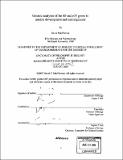| dc.contributor.advisor | Tyler Jacks. | en_US |
| dc.contributor.author | MacPherson, David (David P.) | en_US |
| dc.contributor.other | Massachusetts Institute of Technology. Dept. of Biology. | en_US |
| dc.date.accessioned | 2006-07-31T15:30:38Z | |
| dc.date.available | 2006-07-31T15:30:38Z | |
| dc.date.copyright | 2005 | en_US |
| dc.date.issued | 2005 | en_US |
| dc.identifier.uri | http://hdl.handle.net/1721.1/33752 | |
| dc.description | Thesis (Ph. D.)--Massachusetts Institute of Technology, Dept. of Biology, 2005. | en_US |
| dc.description | Includes bibliographical references. | en_US |
| dc.description.abstract | The RB and p53 genes play central roles in cell cycle and checkpoint control, apoptosis and many other biological processes. These are central tumor suppressor genes that are each inactivated in many human cancers. Mouse genetic analyses have been used to dissect roles of these genes in development and cancer. Targeted disruption of the retinoblastoma gene in mice leads to embryonic lethality in midgestation accompanied by defective erythropoiesis. Rb-l- embryos also exhibit inappropriate cell cycle activity and apoptosis in the central nervous system (CNS), peripheral nervous system (PNS), and ocular lens. Loss of p53 can prevent the apoptosis in the CNS and lens; however, the specific signals leading to p53 activation have not been determined. We tested the hypothesis that hypoxia caused by defective erythropoiesis in Rb-null embryos contributes to p53-dependent apoptosis and found upregulation of hypoxia- inducible genes in CNS tissue from Rb-l- embryos. The Cre-loxP system was used to generate embryos in which Rb was deleted in the CNS, PNS and lens, in the presence of normal erythropoiesis. | en_US |
| dc.description.abstract | (cont.) In contrast to the massive CNS apoptosis in Rb-null embryos at E13.5, conditional mutants did not have elevated apoptosis in this tissue. There was still significant apoptosis in the PNS and lens, however. Rb-l- cells in the CNS, PNS, and lens underwent inappropriate S-phase entry in the conditional mutants at E13.5. By E18.5, conditional mutants had increased brain size and weight as well as defects in skeletal muscle development. These data supported a model in which hypoxia is a necessary cofactor in the death of CNS neurons in the developing Rb-mutant embryo. Cells in the human retina are extremely sensitive to loss of function of the retinoblastoma tumor suppressor gene RB. Although retinoblastoma is thought to have developmental origins, the function of Rb in retinal development has not been fully characterized. We also used the Cre-loxP system to study the role of Rb in normal retinal development and in retinoblastoma in the mouse. In late embryogenesis, Rb-deficient retinas exhibited ectopic S-phase and high levels of p53-independent apoptosis, particularly in the differentiating; retinal ganglion cell layer. | en_US |
| dc.description.abstract | (cont.) During postnatal retinal development, loss of Rb led to more widespread retinal apoptosis, and adults showed loss of rod photoreceptors and bipolar cells. Conditional Rb mutation in the retina did not result in retinoblastoma formation even in a p53-mutant background. We show that loss of Rb and the Rb family member pl130-deficient leads to retinoblastoma. Phosphorylation of the p53 tumor suppressor at Ser20 (murine Ser23) has been proposed to be critical for disrupting p53 interaction with its negative regulator, MDM2, and allowing p53 stabilization. To determine the importance of Ser23 for the function of p53 in vivo, we generated a mouse in which the endogenous p53 locus was targeted to replace Ser23 with alanine. We show that in mouse embryonic fibroblasts generated from Ser23 mutant mice, Ser23 mutation did not dramatically reduce ionizing radiation (IR)-induced p53 protein stabilization or p53-dependent cell cycle arrest. However, in Ser23 mutant thymocytes and in the developing cerebellum, p53 stabilization following IR was decreased and resistance to apoptosis was observed. | en_US |
| dc.description.abstract | (cont.) Homozygous Ser23 mutant animals had a reduced lifespan, but did not develop thymic lymphomas or sarcomas that are characteristic of p53-/- mice. Instead, Ser23 mutant animals died between 1 and 2 years with tumors that were most commonly of B-cell lineage. These data support an important role for Ser2O/23 phosphorylation in p53 stabilization, apoptosis and tumor suppression. | en_US |
| dc.description.statementofresponsibility | by David MacPherson. | en_US |
| dc.format.extent | 283 leaves | en_US |
| dc.format.extent | 15131916 bytes | |
| dc.format.extent | 15145273 bytes | |
| dc.format.mimetype | application/pdf | |
| dc.format.mimetype | application/pdf | |
| dc.language.iso | eng | en_US |
| dc.publisher | Massachusetts Institute of Technology | en_US |
| dc.rights | M.I.T. theses are protected by copyright. They may be viewed from this source for any purpose, but reproduction or distribution in any format is prohibited without written permission. See provided URL for inquiries about permission. | en_US |
| dc.rights.uri | http://dspace.mit.edu/handle/1721.1/7582 | |
| dc.subject | Biology. | en_US |
| dc.title | Genetic analyses of the Rb and p53 genes in murine development and tumorigenesis | en_US |
| dc.type | Thesis | en_US |
| dc.description.degree | Ph.D. | en_US |
| dc.contributor.department | Massachusetts Institute of Technology. Department of Biology | |
| dc.identifier.oclc | 65195898 | en_US |
